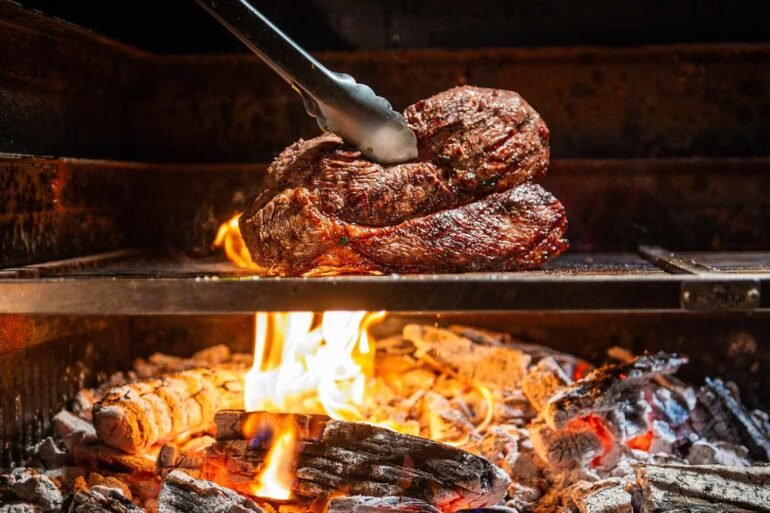:max_bytes(150000):strip_icc():format(jpeg)/These-Are-the-Steakhouses-America-Is-Flocking-To-FT-DGTL0925-e69a48d037eb4d329b5b14d56fcb2203.jpg)
- More than 90% of steak dinners are ordered at casual chain restaurants, where consistency and value are major draws for budget-conscious diners.
- Ribeye, sirloin, filet mignon, and New York strip remain the most popular cuts, with grilled steak being strongly preferred across generations.
- Diners say ambiance, plating, and reliability make steakhouse meals feel like a budget-friendly luxury worth returning for, even during tougher economic times.
Even when budgets are tight, Americans still love a steakhouse dinner.
Chains like LongHorn and Texas Roadhouse are seeing big wins among consumers craving that experience, according to new research from Cargill. The company’s latest report surveyed diners on their top steakhouse priorities — and found that more than 90% of steaks are ordered at casual chains.
For many, personal preferences align closely with money-saving habits. As senior consumer insights manager, Lucy Woods explains, consumers gravitate toward familiar restaurants they trust to deliver a satisfying meal. That sense of confidence often drives the decision to return to the same steakhouse again and again.
“Sometimes, you just need to go out and celebrate — or reward yourself and spend quality time together. There’s a large emotional driver behind steak,” Woods tells Food & Wine. “We’re seeing this chain growth because [consumers] know it’s going to be good. They’ve had experiences at these restaurants before, which gives them the confidence that it’ll be worth it.”
Visitor data backs that up. Despite slowing growth across much of the restaurant industry, traffic at Texas Roadhouse and LongHorn Steakhouse has steadily risen since April 2024, according to Placer AI. In the third quarter of 2024, visits to Texas Roadhouse jumped 5.9% year-over-year, while LongHorn saw a 4.0% increase. Both chains outperformed the broader dine-in category, making them standouts during a challenging period for the restaurant industry.
Millennials, in particular, show a strong preference for chains when it comes to steak. Overall, budget-conscious diners are prioritizing reliability, satisfaction, and the overall experience — or as Woods puts it, “the stakes are high.”
Here’s how Americans prefer their steak
Consistency is where steakhouse chains shine. Diners know exactly what to expect, and that dependability helps justify the spend. Four cuts dominate menus across all age groups: ribeye (ordered by 52% of consumers), sirloin (46%), filet mignon (45%), and New York strip (43%). Older diners also lean toward prime rib, a favorite among those seeking indulgence.
When it comes to preparation, grilling is the top choice, preferred by 73% of consumers. Smoked steak appeals to 21%, especially Millennials and Gen Z, while braised steak also finds favor among younger diners. Whatever the method, consistency and familiarity remain the key ingredients driving America’s love for chain steakhouses.
Most-ordered steak cuts in America
- Ribeye: Ordered by 52% of diners
- Sirloin: Ordered by 46% of diners
- Filet Mignon: Ordered by 45% of diners
- New York Strip: Ordered by 43% of diners
Aiming for higher satisfaction
While steakhouses can stretch already tight budgets, Woods says the overall experience still delivers value. About a quarter of diners reported being dissatisfied with their last steak dinner, according to Cargill, but many continue to view chain steakhouses as an affordable luxury — a chance to enjoy a meal that feels special without breaking the bank. Plating, ambiance, and professional preparation all contribute to an outing that feels worth it.
“Especially today, with how tight consumers’ wallets are, they want a total experience to make it worth it,” Woods explains. “Think culinary expertise, whether that’s preparation in a new way or steak crust. Consumers have a hard time getting that crust [at home].”
Clear communication also shapes satisfaction. While 83% of diners feel confident ordering doneness, only 67% feel comfortable discussing cuts. Factors like tenderness, sear, and beef type may be talked about less often, but they still influence how much consumers trust the experience — and why chains continue to thrive.
Nicolette Baker
2025-09-29 04:22:00

